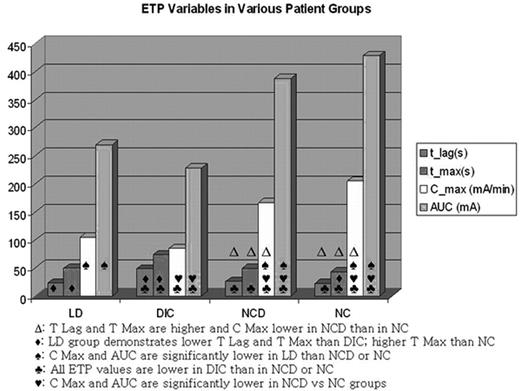Abstract
Introduction Endogenous Thrombin Potential (ETP) is felt to offer a global assessment of coagulation status using continuous photometric measurement of fluorescence emitted, followed by cleavage of a synthetic thrombin substrate. In this study we sought to explore differences in the ETP profile of patients diagnosed with Dissemintated Intravascular Coagulation (DIC) and to examine whether ETP can aid in the discrimination of patients with DIC or End Stage Liver Disease, who can often display similar testing profiles.
Methods Patients with test results interpreted as diagnostic for DIC, Liver Disease (LD), and neither DIC nor Liver Disease (NCD) were selected for evaluation. A total of 55 potential patients were identified and, of these, 45 (82%) were suitable for testing. Samples for testing had been collected in trisodium citrate, double centrifuged, and stored at −70° C for a mean of 15 months. The ETP test (Dade Behring, Marburg, Germany) was performed utilizing the BCS instrument according to the manufacturer’s guidelines. Results for T Lag, T Max, C Max, and AUC were compared between patient groups using two tailed T-test with a P value of <0.05, considered significant.
Results Tests were uninterpretable in 9/45 samples (20%) and therefore the total patient data set included 36 samples (10 in the LD group, 14 in the DIC group, and 12 in the NCD group). There were 7 female and 13 male controls (NC). Liver disease patients express lower values for T Lag and T Max than do DIC patients and lower C Max and AUC than either NCD or NC groups. All ETP variables are significantly lower in the DIC group vs either NCD or NC. NCD and NC groups exhibit minor, but significant differences in all variables, the greatest differences being lower C Max and AUC in NCD vs NC (see Figure 1). Similar differences were observed in gender specific analysis.
Conclusion While ETP determination may be helpful as an additional piece of information in distinguishing between DIC and End Stage Liver Disease patients, differences between the two groups were minor and there was considerable overlap. Paradoxically, the T Max (time to peak thrombin generation) was longer, and both the C Max (which represents the slope of the rise in thrombin generation) and AUC (total thrombin generation) lower, in DIC than in all other groups compared. This is possibly the result of inhibition from significantly higher levels of fibrinogen degradation products and D-Dimers in the DIC vs Liver Disease and non-DIC groups (data not shown). Additional studies using ETP in DIC, Liver Disease, and other hyper- and hypo-coagulable states are necessary.
ETP Variables in Various Patient Groups
Author notes
Disclosure: No relevant conflicts of interest to declare.


This feature is available to Subscribers Only
Sign In or Create an Account Close Modal